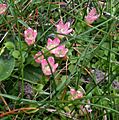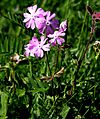Farnham Mires facts for kids
| Site of Special Scientific Interest | |

The mire
|
|
| Area of Search | North Yorkshire |
|---|---|
| Coordinates | 54°02′18″N 1°29′07″W / 54.0384°N 1.4853°W |
| Interest | Biological |
| Area | 10.3341 hectares (0.1033 km2; 0.03990 sq mi) |
| Notification | 1954 Revised 13 January 1984 |
| Location map | Magic Map (Defra) |
Farnham Mires is a Site of Special Scientific Interest, or SSSI, to the east of the village of Farnham, North Yorkshire, England. It consists of a spring-fed marshy fen or mire with reeds and sedge, and drier calcareous grassland containing a diverse range of flora. It has a history of poaching and fox hunting, but since the late 19th century, the attention of botanists has been drawn to its large variety of flowering plants. It has received some consideration on this account since 1944, and from 1954 it was designated SSSI status. This site has no facilities, and is not open to the public.
Contents
Site history
In 1856, James Frankland, Thomas Jackson and James Kendrew were sentenced to three, six and four months imprisonment with hard labour, respectively, for poaching at Farnham Mires and for beating those who tried to apprehend them. In the 19th century, Farnham Mires was located in fox hunting country, it being close to Scriven Park. The York and Ainsty Hunt used to find foxes there.
However, by the end of the 19th century, attention was turning to the botanical value of the site. It drew the attention of the Yorkshire Naturalists' Union (YNU), who included it in their botanical and zoological excursions of 1885 and 1894. During the 1885 excursion the Reverend Robert Elmhirst, vicar of Farnham and Brearton, presented "a large number of the rarest botanical specimens, which are found on Farnham Mires" to the botanical section of the YNU.
Oenanthe Lachinalii or water dropwort, Samolus valerandi or water pimpernel, Euphrasia nemorosa or eyebright, blunt-flowered rush, fen pondweed, Eriophorum latifolium or cotton grass and black sedge, were found on the site in 1943-1944. "In 1944, Farnham Mires were scheduled for reclamation and cultivation, but an approach was made to the appropriate agricultural committee and to the Wild Plant Conservation Board, and the reclamation plans were cancelled."
Site location and designation
Farnham Mires Local Wildlife Site is a 10.3341 hectares (0.1033 km2; 0.03990 sq mi) biological Site of Special Scientific Interest (SSSI), featuring a "spring-fed marsh" and drier calcareous grassland over Magnesian Limestone. Some original biodiversity, especially of flora, remains in the southern section of the site, but agricultural improvement has compromised natural flora in the northern section. The site is not open to the public, and has no facilities. It is situated to the west of Farnham, North Yorkshire, on the north side of Low Moor Lane.
The SSSI was first notified in 1954, the notification being revised on 13 January 1984, because it retains "the original grassland and marsh communities of Farnham Mires." That is, it features calcareous grassland with underlying Magnesian Limestone, allowing some rare species of flora to grow in the topsoil, along with some local species. This is valued even though the flora in northern part of the site has been compromised by agricultural improvement. It is also designated a Local Wildlife Site. This site is "one of a very few remaining sedge and rush dominated marshland communities in the Vale of York," the others being Upper Dunsforth and Kirkby Wharfe SSSIs.
Significant site content
Note: unless otherwise stated, the photographs in this section are for illustrative purposes only, and were not taken at the Farnham Mires site.
Flora
In 1943, the site was visited by botanists George Taylor and E.C. Wallace. They saw the place "thickly carpeted" with cowslip and hairy violet, and "at the climax of the flowering season there [was] a truly magnificent array of fragrant orchids and spotted orchids." The following is a list of the "more interesting" plants which they saw in 1943: salad burnet, parsley water dropwort, pepper saxifrage, guelder rose, hemp-agrimony, hoary ragwort, bird's-eye primrose, brookweed, butterwort, common centaury, common gromwell, Rhinanthus stenophyllus or yellow rattle, Potamogeton densus or pondweed, twayblade, green-winged orchid, early purple orchid, heath spotted orchid, bee orchid, fragrant orchid, autumn crocus or meadow saffron, blunt-flowered rush, black bog-rush, sedge Blysmus compressus, bristle club-rush, sedge Eriophorum latifolium, hairy sedge, distant sedge, sedge Carex fulva, sedge Carex lepidocarpa, glaucous sedge, carnation sedge, sedge Carex caryophyllea, brown sedge, flea sedge, heath false-brome, erect brome and adder's tongue.
As of 1984, the marsh area mostly contained common reed, Juncus inflexus or hard rush, and blunt-flowered rush, along with great willowherb, purple loosestrife and meadowsweet. Where there was more groundwater, there was a "carpet of bryophytes", besides Carex lepidocarpa or long-stalk yellow sedge, carnation sedge, Valeriana dioica or marsh valerian and marsh arrowgrass, all of which grew among the more numerous lesser hairy-willowherb, marsh pennywort and marsh horsetail.
Around the marsh is grassland on neutral soil. On this grows twayblade, common spotted orchid, common agrimony, pepper saxifrage and knapweed, with other herbs.
There is also an area of "species-rich calcareous grassland" which is not waterlogged, and which has patches of buckthorn and hawthorn. This area is maintained with light grazing, to encourage grasses, sedges and diverse herbs. The grasses are purple moor-grass, heath grass, quaking grass and hairy oat. The sedges include glaucous sedge in particular. There are plenty of orchids: bee orchid and fragrant orchid. The herbs include adder’s-tongue fern, cowslip, hoary plantain, yellow rattle and betony.
The special wetland plants noted in Natural England's citation for the SSSI are: Oenanthe lachenalii or parsley water dropwort, brookweed and bog pimpernel. The drier-land plants of note are felwort or autumn gentian, and bird’s-eye primrose.
Fauna
This SSSI was not designated as such for its fauna, the only mention on Natural England's assessment documents being possible rabbit nuisance in 2015. However on 9 March 1970, 60,000 starlings were reported in a hawthorn thicket on the site. A Bradford University student thesis lists five undated historical reports of the red fox at the site, and A History of the Bramham Hunt (1898) gives an instance of finding foxes there.
Other biota
When Taylor and Wallace visited the site in 1943, they noticed a "rich insect fauna," and Taylor reported that in view of that virtue, together with the variety of flora then present, "it would seem that the area has a strong claim for consideration in any scheme for the creation of nature reserves."
Maintenance
Mire
This is a flush and spring fen, which has to be maintained as such, to ensure continued biodiversity. This is because the minerals in the groundwater seepage at this mire support, for example, rush, sedge, liverwort and moss. Therefore the underground aquifers should not be compromised by commercial water extraction, nor should they be contaminated by heavy use of agricultural fertilisers or by industrial pollution. A little fertiliser can be used, but downhill of the springs. Light grazing should be employed to keep the springs clear, and the grasses short.
Grassland
The calcareous grassland potentially supports a large diversity of plants, but only if maintained to prevent it being overgrown with rank grasses and scrub. Light winter grazing is recommended, to promote vegetation of varying height, and that in turn will support invertebrates and other wildlife. Pesticides are discouraged to protect the diverse plant life here, but fertilisers are also discouraged because the protected plants require the naturally poor soil conditions of the calcareous grassland.



































